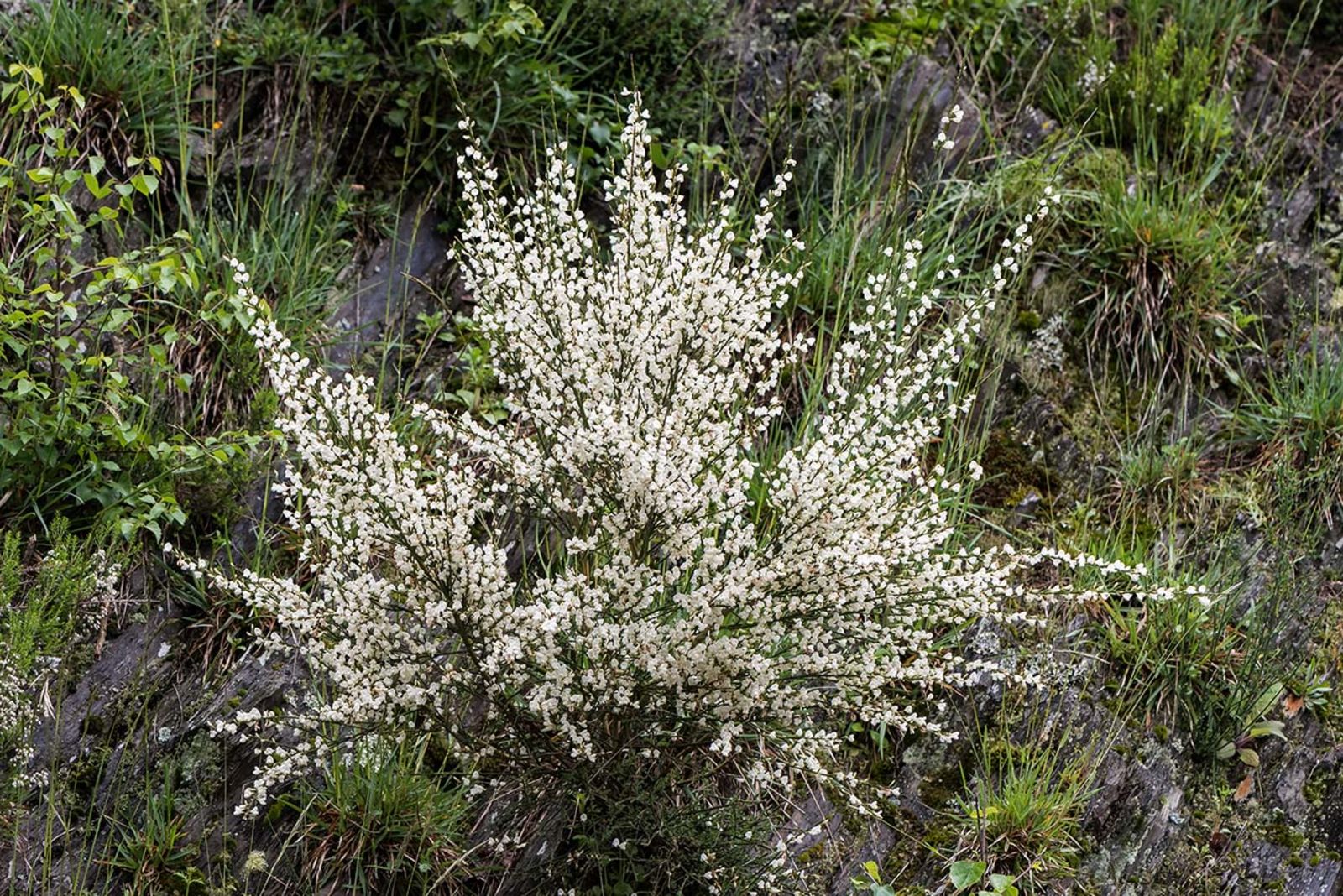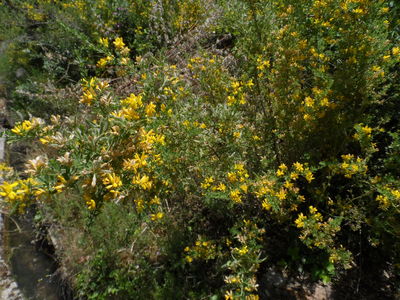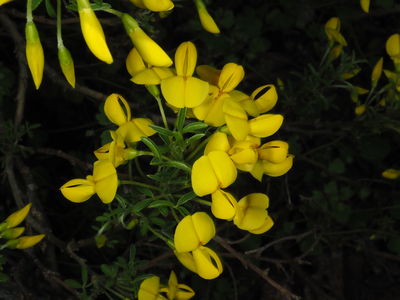Distinctive genus and, with the other minor segregates in the subtribe mostly included by Polhill (1976), easily distinguished from the Genistinae by the characteristic falcate rather than oblong keel, though components of the two subtribes have often been intermixed in the past. These segregates persist in local floristics. The scheme of Bisby (1981) is adopted here, with the mostly monotypic basally branching elements, Podocytisus, Cytisophyllum, Petteria and Argyrocytisus excluded from Cytisus as well as the minor segregates, Calicotome and Lembotropis (which probably should be re-included now, see below). Bisby also excluded the large segregate Chamaecytisus, which has nearly 30 species with a tubular calyx, but is re-included here following Cristofolini (1991); Käss & Wink (1997); Cubas et al. (2002) and Wink & Mohamed (2003). Floristic accounts for E Europe, the Iberian Peninsula and Macaronesia, however, still tend to segregate Chamaecytisus (e.g., Yakovlev, 1996, but not Talavera & Salgueiro, 1999); the circumscription remains the same whether at generic or sectional level
Bisby (1981: 409–425) divided the Genisteae into subtribes Genistinae and Lupininae, a principal division taking both morphological and chemical evidence into account. Polhill (1976) drew attention to the similarities between woody Thermopsideae (Anagyris and allies) and the main part of Genisteae, and between the herbaceous genera of that tribe, Baptisia and Thermopsis, and Lupinus. Crisp et al. (2000) emphasise the lability of staminal fusion in genistoid tribes as a whole, and it might be supposed that the free-stamened Thermopsideae would be better included in Genisteae. In recent molecular analyses (Käss & Wink, 1997; Crisp et al., 2000; Wink & Mohamed, 2003; Wojciechowski et al., 2004), however, all Thermopsideae grouped with Sophora and close allies, and Lupinus was relatively basally branching in Genisteae, above the southern African genera Melolobium and Dichilus (previously placed in Crotalarieae). The similarities between Baptisia, Thermopsis and Lupinus are likely due to strong ecological convergence in temperate habitats.
The Genisteae forms part of a monophyletic clade, the ‘core genistoids’ which also includes Crotalarieae, Podalyrieae, Thermopsideae, Brongniartieae, Euchresteae and Sophoreae sens. strict. (Crisp et al., 2000; Pennington et al., 2000a; Kajita et al., 2001). Genisteae appears to be sister to the Crotalarieae and both are sister to the Podalyrieae (Crisp et al., 2000; Wojciechowski et al., 2004). There is now convincing evidence that Melolobium, Dichilus, Argyrolobium and Polhillia (the Argyrolobium clade of Van Wyk & Schutte, 1995a), together with Anarthrophyllum (and probably Sellocharis), are part of Genisteae and that the similarities with the Crotalarieae (the remarkable parallels between Dichilus and Lebeckia for example) are superficial only (e.g., Wink & Mohamed, 2003; Wojciechowski et al., 2004). Crisp et al. (2000) suggested that this group of genera may be sister to Crotalarieae but their analysis did not include critical genera such as Adenocarpus and Lupinus. Less emphasis is now given to stamen fusion, and these genera have been formally transferred to Genisteae based on the shared presence of a trifid lower lip of the calyx and the distinctive quinolizidine alkaloids of the a-pyridone type (Van Wyk & Verdoorn, 1990; Van Wyk & Schutte, 1995a; Wink & Mohamed, 2003). Van Wyk et al. (1989) suggest that Spartidium, currently in the Crotalarieae, may be better placed in Genisteae.
More detailed molecular studies are necessary to fully assess relationships of the genera. Käss & Wink (1997) undertook the first detailed molecular analysis of Genisteae using rbcL and ITS sequences, and limited ITS sampling by Crisp et al. (2000) is largely congruent with this, also supporting a paraphyletic Argyrolobium. The two southern African species of Argyrolobium analysed by Crisp et al. (2000) are dispersed within the Genista group (linked to Spartium and Retama). Käss & Wink (1997) sampled four species of Argyrolobium, two from southern Africa and two from the Mediterranean Region, and these are more basally branching in the tribe (Fig. 38), although the Mediterranean species A. zanonii (Turra) P.W.Ball groups elsewhere near the base of the Cytisus group. These results are largely supported in the chloroplast rbcL analyses of Wink & Mohamed (2003), with more species of Argyrolobium sampled and a placement of A. zanonii as sister to the combined Genista and Cytisus complexes. The ITS analysis of mainly Spanish Genisteae (Pyne, 1999) is also largely congruent with Käss & Wink (1997), except for Argyrolobium where one southern African species groups within the Genista complex and A. zanonii is basally branching to it. The sequence for Lembotropis is acknowledged as suspect in the Pyne analysis, and its position allied to Cytisus (as C. nigricans) (Käss & Wink, 1997; Wink & Mohamed, 2003) is more in agreement with morphological evidence. The biggest problem areas remaining, besides resolving relationships within Argyrolobium, are generic delimitation within the Cytisus and Genista groups and the decision whether to recognise a few large, or many small genera. Morphologically, Argyrolobium is more coherent than the current molecular evidence seems to suggest and a broader sampling and reanalysis would be informative. For the main part of Genisteae, the segregation of the groups of genera around Cytisus and Genista is evident (Käss & Wink, 1997; Cubas et al., 2002; Wink & Mohamed, 2003; Pardo et al., 2004), but the placement of many genera is not well supported. Käss & Wink (1997) conclude that the position of many of these genera which lie between the Cytisus and Genista complexes cannot be established with certainty, probably because of the small number of nucleotide substitutions available (due to rapid and recent diversification) and homoplasy. So as not to obscure the morphological relationships prior to further molecular studies, the subtribal classification of Talavera & Salgueiro (1999), slightly extended and modified, is outlined here. The Genisteae here comprises 25 genera and (551)–562–(572) species (Fig. 38). Adenocarpinae Rouy — Melolobium, Dichilus, Polhillia, Argyrolobium and Adenocarpus (South Africa, tropical Africa (mostly montane) and Mediterranean region, thinly to the Indian subcontinent); this group largely comprises a basal grade on molecular evidence, but all genera need further analysis. Lupininae Rouy — Lupinus, Anarthrophyllum, Sellocharis (Americas, particularly montane regions in the west; Mediterranean region, tropical Africa). Cytisinae (Horan.) Benth. — Cytisophyllum, Argyrocytisus, Petteria, Cytisus, Lembotropis, Calicotome (Europe, Mediterranean region and Macaronesia). Laburninae Rouy — Laburnum, Podocytisus, Hesperolaburnum (Mediterranean, principally Balkans and Atlas Mts); these genera are treated here as being nested within Cytisinae. Erinaceinae Talavera — Erinacea (SW Europe and N Africa); genera in the Erinaceinae and in Spartiinae below, are treated here as being nested within the Genistinae. Spartiinae Benth. — Gonocytisus, Retama, Spartium (Mediterranan region). Genistinae Bronn — Genista, Echinospartum, Stauracanthus, Ulex (Europe, mostly western, and Mediterranean region)






